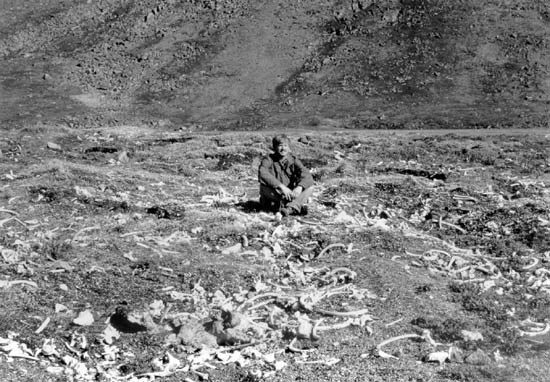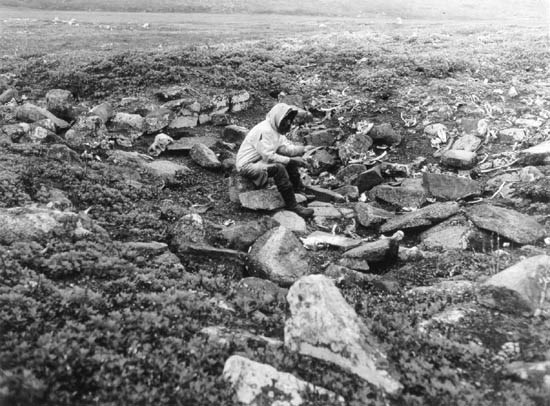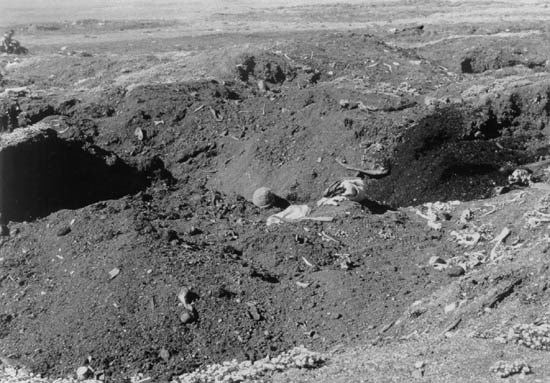
NPS Photo / Susan Morton, National Historic Landmarks Program
Gambell Sites
Nome County, AK
Designated an NHL: December 29, 1962
Designation withdrawn: January 13, 1989
The five archaeological properties comprising the Gambell Sites represent two thousand years of Eskimo history on Saint Lawrence Island. These sites were critical in establishing the chronology of human habitation on the island. The prehistoric cultural phases of Okvik, Old Bering Sea, Punuk, Birnirk, and Thule, described by archaeologists based on excavations at the Gambell Sites, have provided a basis for other archaeological research in the Bering Sea region.
The five sites, named Hillside, Mayughaaq, Ayveghyaget, Old Gambell, and Seklowaghyag, are located on Saint Lawrence Island in the Bering Strait, near the town of Gambell, a Yupik Eskimo community. Archaeological excavations at several of the sites, beginning in 1927 and continuing into the 1930s, uncovered the first evidence of the prehistoric inhabitants of the island. Additional excavations at the Gambell Sites were undertaken in the late 1960s and the early 1970s.

NPS Photo / Paul J.F. Schumacher, National Historic Landmarks Program
On the basis of this work, the basic sequence of the cultures on the island was established. The Gambell Sites have been classified by archaeologists as part of the maritime-oriented Thule tradition (also called Northern Maritime or Neo-Eskimo), that extended over an area of the Arctic from northeast Siberia to Greenland. The Thule tradition first appeared in the earliest cultures of the Bering Strait islands. Among other traits, cultures of this tradition relied heavily on marine resources, especially the open water hunting of sea mammals. Settlements of the Okvik and Old Bering Sea cultures, the earliest cultures of the Thule tradition, appeared on Saint Lawrence Island approximately 2,000 years ago. Okvik and Old Bering Sea remains were subsequently found on other islands of the Bering Strait and on the coast of Siberia. These cultures were succeeded by the Punuk culture which focused on both coastal and marine resources. The succeeding Birnirk culture was possibly influenced by Old Bering Sea and Okvik, but focused on land resources in addition to marine ones. From Birnirk, the historically-documented Eskimo cultures developed.
At the Hillside site, remains of the Okvik and Old Bering Sea cultures were uncovered. Several winter houses and associated middens were excavated which dated to Okvik and Old Bering Sea occupations. The Mayughaaq site, a permanent village, contained numerous winter house sites, an associated midden mound, and many burials. The site represents a transitional period between the Old Bering Sea culture and the Punuk culture. The Ayveghyaget site was a Punuk village, occupied over a lengthy period, with a midden mound and cemetery. The Old Gambell and Seklowaghyag sites consisted of a midden representing a lengthy occupation, starting with the Punuk culture and ending in the early twentieth century.
The Gambell Sites were designated a National Historic Landmark in 1962. This designation recognized their importance in establishing a chronological sequence of cultures on Saint Lawrence Island and in regional prehistory. Additionally, the sites are important to the discipline of archaeology, as the first in the greater Bering Strait region to be scientifically investigated and reported. It was noted at the time of this designation, however, that all of the sites except Hillside had been significantly disturbed.

NPS Photo / Susan Morton, National Historic Landmarks Program
The poor condition of the sites was caused not only by the destructive process of archaeology, but who also by local residents digging to recover old ivory. For almost as long as archaeologists have worked at the sites, residents of Gambell have been excavating as well. This pursuit was partly inspired by Otto Geist's archaeological work in the 1920s, during which he paid local diggers according to the amount of ivory they uncovered, but trade in ivory has always been a facet of European contact with the islanders.
Few salaried jobs or sources of cash income exist on the island, yet to support a contemporary lifestyle, cash is needed to purchase the necessities of life. The decline of economic opportunities in other areas, such as trapping, has made the ‘recycling' of ivory from archaeological sites an attractive opportunity. Restrictions on the sale of fresh walrus ivory, under the federal Marine Mammal Protection Act, have also acted to accelerate the destruction of the sites.
Both worked and unworked ivory is recovered from the sites and much of this material is sold off the island to ivory dealers. Sivuqaq, Inc., the native corporation that owns part of the island, has participated in this ivory trade as a broker since 1983, attempting to maximize the residents' return on the excavated ivory. In 1984, the corporation commissioned a study of archaeological sites on the island to assess their remaining value as cultural and scientific resources and to consider site conservation and museum possibilities. As a result of the ongoing losses to these sites, however, the National Historic Landmark designation for the Gambell Sites was withdrawn on January 13, 1989. The Old Gambell and Seklowaghyag sites were removed from the National Register of Historic Places, but Miyowagh, Hillside, and Ayveghyaget were believed to have continuing research potential and therefore remain listed in the National Register.
Mining of the sites has continued since the withdrawal of the Landmark designation. In a 1993 Journal of Field Archaeology article, David Staley described the continuing use of St. Lawrence Island archaeological sites as a source of cash income for the residents. Observing and discussing the activity with the diggers, Staley found that the digging was primarily motivated by economics, but that other factors, such as tradition, recreation, and even education played a part. Many Gambell residents feel that they are recovering their heritage and dispute the exclusivity of archaeologists to produce information about their past. Removal of artifacts from the sites by archaeologists is viewed as both a cultural and an economic loss for the residents.
Last updated: August 29, 2018
